In the present study, poly[1-methoxy-4-(2′-ethylhexyloxy)-p- phenylenevinylene] (MEH-PPV) was synthesized, modified and characterized by FTIR, NMR, GPC, UV/vis absorption, fluorescence, and mass spectroscopy. The effective conjugation length was controlled by introducing physical and chemical defects into the chain backbone. It was observed that absorption and emission spectra of polymer chains were blue-shifted by importing structural deficiencies. Chemical defects were introduced by controlled oxidation of vinylene double bonds using m-chloroperbenzoic acid and physical defects were induced by tuning polymer-solvent interactions (varying solvent quality). It was shown for the first time that the recorded fluorescence spectrum of MEH-PPV can be reconstructed using the emission data of oligomeric constituents and the contribution of chromophores with different numbers of repeat units to overall emission can be quantified. The effect of excitation energy on the emission pattern was also investigated. It was shown that the emission contribution of shorter chromophores to overall emission is detectable using high excitation energies. Finally, atomistic molecular dynamic (MD) simulation was used to investigate the polymer chain conformation in methanol and chloroform. The results obtained from torsional angles studies confirmed the presence of a great number of induced physical defects in the backbone and, hence, a collapsed conformation of polymer chains in methanol. Evaluations of physical defects along the chain proposed the average number of coplanar phenyl rings of ∼5 and 14 for polymer chains in methanol and chloroform respectively.

In the present study, poly[1-methoxy-4-(2′-ethylhexyloxy)-p- phenylenevinylene] (MEH-PPV) was synthesized, modified and characterized by FTIR, NMR, GPC, UV/vis absorption, fluorescence, and mass spectroscopy. The effective conjugation length was controlled by introducing physical and chemical defects into the chain backbone. It was observed that absorption and emission spectra of polymer chains were blue-shifted by importing structural deficiencies. Chemical defects were introduced by controlled oxidation of vinylene double bonds using m-chloroperbenzoic acid and physical defects were induced by tuning polymer-solvent interactions (varying solvent quality). It was shown for the first time that the recorded fluorescence spectrum of MEH-PPV can be reconstructed using the emission data of oligomeric constituents and the contribution of chromophores with different numbers of repeat units to overall emission can be quantified. The effect of excitation energy on the emission pattern was also investigated. It was shown that the emission contribution of shorter chromophores to overall emission is detectable using high excitation energies. Finally, atomistic molecular dynamic (MD) simulation was used to investigate the polymer chain conformation in methanol and chloroform. The results obtained from torsional angles studies confirmed the presence of a great number of induced physical defects in the backbone and, hence, a collapsed conformation of polymer chains in methanol. Evaluations of physical defects along the chain proposed the average number of coplanar phenyl rings of ∼5 and 14 for polymer chains in methanol and chloroform respectively.
